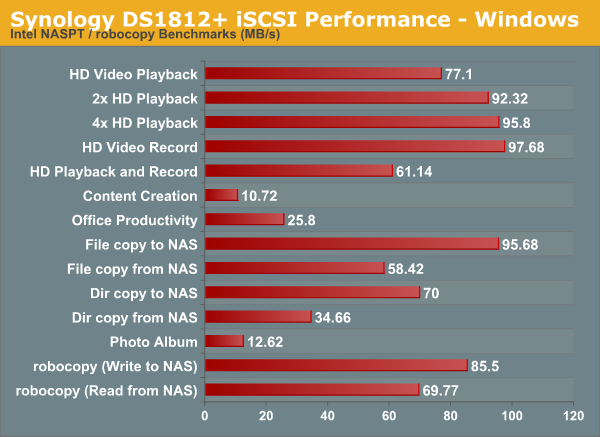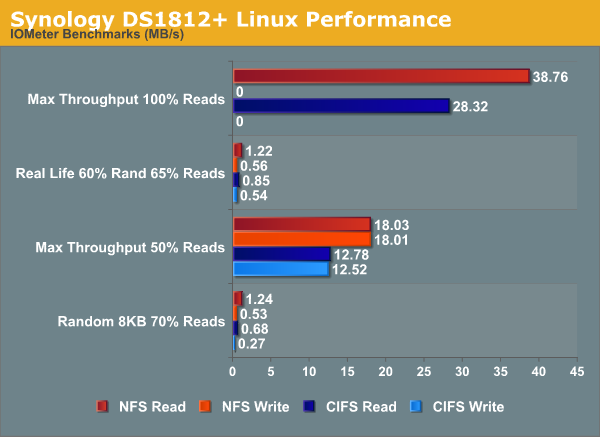Synology DS1812+ 8-bay SMB / SOHO NAS Review
by Ganesh T S on June 13, 2013 4:00 PM EST- Posted in
- NAS
- Storage
- Synology
- Enterprise
Single Client Performance - CIFS, NFS and iSCSI
The single client CIFS performance of the Synology DS1812+ was evaluated on the Windows platforms using Intel NASPT and our standard robocopy benchmark. This was run from one of the virtual machines in our NAS testbed. All data for the robocopy benchmark on the client side was put in a RAM disk (created using OSFMount) to ensure that the client's storage system shortcomings wouldn't affect the benchmark results

We created a 250 GB iSCSI target and mapped it on the Windows VM. The same benchmarks were run and the results are presented below.

A CentOS 6.2 virtual machine was used to evaluate NFS and CIFS performance of the NAS when accessed from a Linux client. In order to standardize the testing across multiple NAS units, the following parameters were used to mount the NFS and Samba shares:
mount -t nfs NAS_IP:/PATH_TO_NFS_SHARE /PATH_TO_LOCAL_MOUNT_FOLDER -o async,hard,proto=tcp,noac
mount -t cifs //NAS_IP/PATH_TO_SMB_SHARE /PATH_TO_LOCAL_MOUNT_FOLDER -o directio
Note that we have not tried to optimize NFS performance for the NAS. In order to keep things as uniform as possible, we will just look at comparative performance on the basis of the default mounting options combined with the above (which are set to avoid caching effects on the client side). The scripts available here were run on IOMeter. The graph below presents the various results.











93 Comments
View All Comments
SirGCal - Friday, June 14, 2013 - link
So again, why not build your own server, cheaper. More effective, more capable. Using your own OS and your own mounting systems. You could even include Samba and NFS directly if you wanted purely. Works for sure then.t-rexky - Friday, June 14, 2013 - link
That approach would work fine for me but unfortunately not for the others at home who need a reasonably user friendly interface...SirGCal - Friday, June 14, 2013 - link
What interface? It's a network storage... It's a mounted drive, or a website address, or a dymanic drive like \192.168.1.100\Share\ That's all you need to get to your data from any system connected to the network. What 'interface' do you use? A webbrowser? Change it to HTTP:// and add Apache or IIS... Don't blame the box because you don't know what you're doing.t-rexky - Friday, June 14, 2013 - link
Please re-read my original post. This has nothing to do with my knowledge or my abilities but rather everything to do with a device that one purchases that claims to do something but fails to do it.SirGCal - Friday, June 14, 2013 - link
Again, this just reenforces my examples of why one should build their own instead of buying someone elses 'package' of problems. You put on your own tools/addons/etc. Put on the parts you need. The interfaces you want. Whatever GUI accesses your users want to use to access it with (ya, they can all be added in almost any flavor of OS in some form)... All this does is give it to you in a plug & pray form factor. I added an update below though from a friend who bought one though and his experiences. Even against my recommendations but, I only advise and support.SirGCal - Friday, June 14, 2013 - link
I have an update for you guys that like these:I have a friend who does too. He has one. To be fair I offered to build him a box like mine also. He went with one of these this time around. He has the same drives as mine this time and it is running RAID 6 (that's what made me think about giving him a call).
Downsides, it's slow. He's only seeing about 120M writes and 180M reads with it. A lot slower then my rig. Plus it can't do all the other dedicated things (Subsonic/Plex/Handbrake/etc) that mine does all the time even over the internet to serve up my files and videos while I'm away. At least he can't figure out how to get it to run Subsonic anyhow...
So it does do RAID 6. Huge bonus there. Kudos to that. But it is also propriotary. Tried taking the array out and putting it on my cards and they didn't recognize it. Common problem with these boxes. Whereas I can take them out of my cards between each other and they all recognize each other between brands as long as they are in standard RAID formats (one benefit of using standard formats). Incase a card ever fails. But even with the SAME network hardware (I bought a spool and we did both of our homes and we got the same switches/routers/etc. so all of that is identical and his house is actually simpler, fewer connections.)
So that's just one real world example but there ya go. At least it does do RAID 6, still Anand dropped the ball on that one and should have tested it for ya/us... Performance seems a bit off but it does work. He hasn't had to do any repairs or rebuilds/grows yet though so can't give anything on that. He built it fully populated out of the door. But at least it does work RAID 6 for those wondering. If your going to go with a box, and a big box at that, at LEAST use RAID 6 or something better. 8 drives is not good for RAID 5...
Jeff7181 - Friday, June 14, 2013 - link
One could argue that RAID6, or even RAID5 for that matter is unnecessary in a home environment where downtime means lost money.Data loss is not (or should not) be a concern. RAID provides performance and fault tolerance.
RAID is not a backup solution and should not be treated as such. You should have another copy of your data elsewhere.
Jeff7181 - Friday, June 14, 2013 - link
That should read... where downtime doesn't mean lost money.SirGCal - Friday, June 14, 2013 - link
Well no. It also simply means a matter of time an data loss... For example. I keep my pictures and home movies on my RAID array also along with my private BluRay/DVD collection. To Re-rip my private collection from scratch would take literally years. To have it on hand is the benefit of the array. Possible but very inconvenient. To lose the pictures and home videos would be catastrophic. I do have backups of those off-sight but, RAID 6 still helps prevent either one of these failures from happening. Hence the use of a very large array anyhow. If you're going big, go smart or don't do it. Just to have to recreate the data, possible or not, would be insanely difficult and time consuming and that is the entire POINT to having the array to begin with. Convenience.Jeff7181 - Monday, June 17, 2013 - link
You've missed my point. My point is that event a total failure of an array should not mean data loss. RAID is not a backup solution. You should be using a backup solution for data you can't afford to lose, not RAID. Lost uptime is not as expensive in most home environments as it is in most business environments. It's convenient to tolerate a hard disk failure with no downtime at home, but in most cases, the downtime isn't costing you money, so all you're buying with that fault tolerance is convenience because again, RAID is not a backup solution - you should have your data backed up elsewhere.